
This recipe is my vegetarian, Thai-inspired take on Pad Thai – a stir-fried rice noodle dish that’s quick, flavorful, and perfect for weeknight meals. While it isn’t a traditional version, it brings together the same sweet, tangy, and umami-rich flavors using tamarind, palm sugar, soy sauce, mushrooms, and plenty of fresh vegetables. With no fish sauce or eggs, this version is ideal for vegetarians and vegans, and is easily customizable with pantry-friendly ingredients.
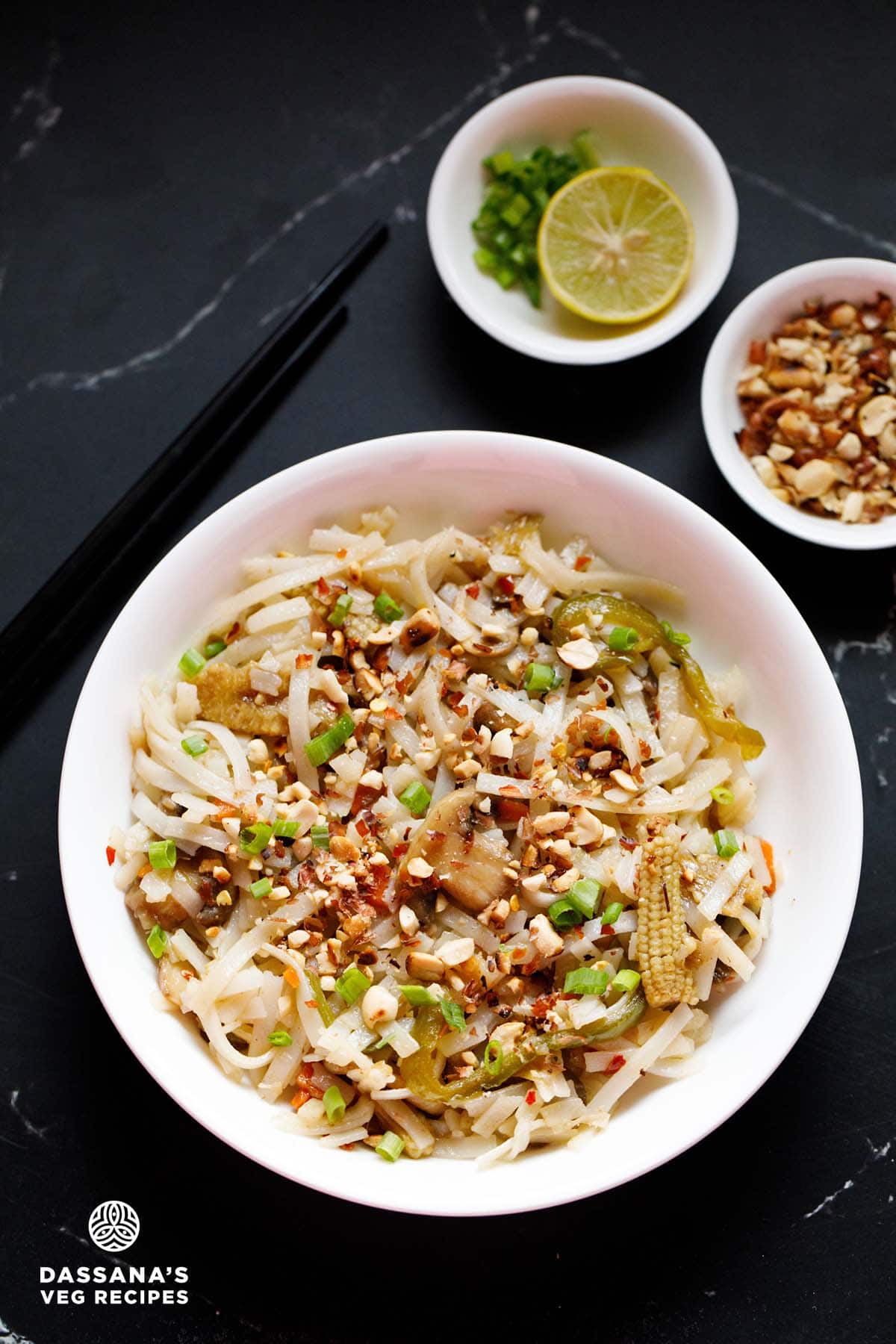

About Pad Thai
Pad Thai is a quick, colorful stir-fried noodle dish bursting with bold flavors. Made with rice noodles, crunchy vegetables, roasted peanuts, and a tangy tamarind-based sauce, it’s a perfect balance of sweet, sour, and savory.
This easy, meat-free version is satisfying, wholesome, and can be customized with your favorite veggies.
During our travels through Thailand, especially in cities like Bangkok and Chiang Mai, we were often drawn to the simplicity and depth of flavor in the vegetarian dishes served at local eateries and bustling street food stalls.
Although Thailand’s street food is famously diverse, being vegetarian sometimes meant fewer options.
Still, we discovered a range of memorable favorites – from crispy Vegetable Spring Rolls and fragrant Green Curry and spicy Red Curry to zingy Som Tam (green papaya salad) and the ever-popular Pad Thai. Each dish offered a perfect mix of bold flavors, fresh ingredients, and that comforting Thai essence.
Pad Thai quickly became our go-to — a harmonious blend of sweet, sour, salty, and spicy notes, paired with soft rice noodles, crunchy peanuts, and fresh vegetables. Served with lime wedges and extra peanuts, it always felt like a complete and satisfying meal.
What Makes This Pad Thai Unique
Inspired by our travels, I created a fully vegetarian and vegan version at home that can be made gluten-free with just a few simple swaps.
This Pad Thai recipe is mild, with a tangy-sweet profile, and features lime juice and peanuts as essential garnishes.
While this isn’t a classic Pad Thai, it draws from the same flavor elements – tanginess from tamarind, sweetness from palm sugar, savory depth from soy sauce, and crunch from roasted peanuts.
Why This Recipe Works
Since I cook vegetarian, I’ve skipped the fish sauce and eggs, and added mushrooms for that rich, umami profile. I often add plant based oyster mushroom powder for extra umami, but it’s optional and can be skipped.
This version is adapted to what’s easily available in my pantry and tailored for vegetarian kitchens, making it a comforting and satisfying one-bowl meal.
Though rice noodles are traditional, any noodles can be used, and tofu makes a great protein-rich addition. I have skipped pickled radish here as the vegetables provide plenty of texture and soak up the flavorful sauce beautifully.
This version doesn’t have the darker brown hue typical of restaurant-style Pad Thai, as I’ve used freshly extracted tamarind water instead of commercially prepared tamarind concentrate or sauce, which tends to be more intensely colored.
That said, the dish still delivers the authentic tangy-sweet flavor Pad Thai is known for. You can always adjust the flavors to suit your taste by varying the amount of tamarind water and sweeteners like palm sugar or brown sugar.
Crushed roasted peanuts and chopped spring onions are my go-to garnishes for this dish, adding both texture and freshness. You can also optionally use coriander leaves (cilantro) if you like.
It is important not to overcook the noodles – they should be tender yet firm, as overcooking can make them sticky or mushy.
This homemade Pad Thai has become a staple in our kitchen – quick, nourishing, and full of vibrant taste. It’s perfect for busy weeknights or as a weekend indulgence.
The recipe is naturally vegan and vegetarian, and can easily be made gluten-free by using gluten-free soy sauce or tamari.
Step-by-Step Guide
How to make Pad Thai
Make Tamarind Water
- Soak 1 tablespoon tamarind in ⅓ to ½ cup hot water for 20 to 30 minutes.
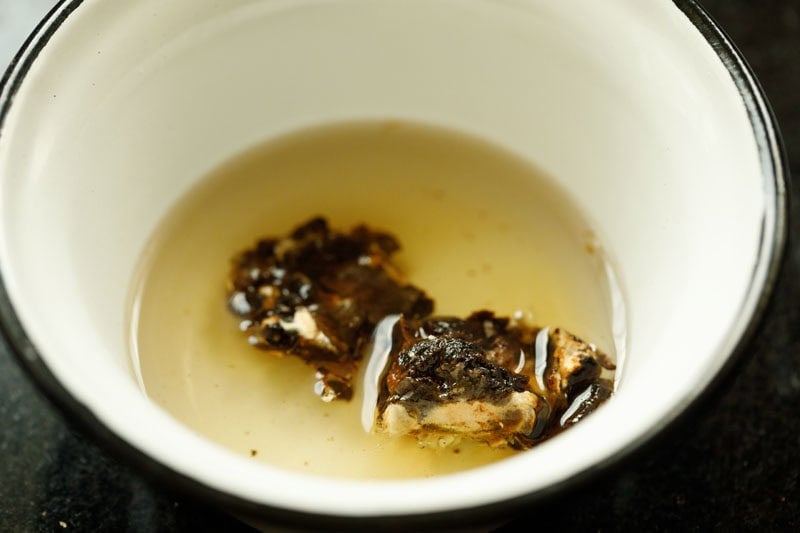

2. Once softened, squeeze and extract the pulp into the water. Discard the fibrous bits and set the tamarind water aside.
Note: If using store-bought tamarind paste, use about 1 to 1½ teaspoons and dissolve it directly into the sauce later.
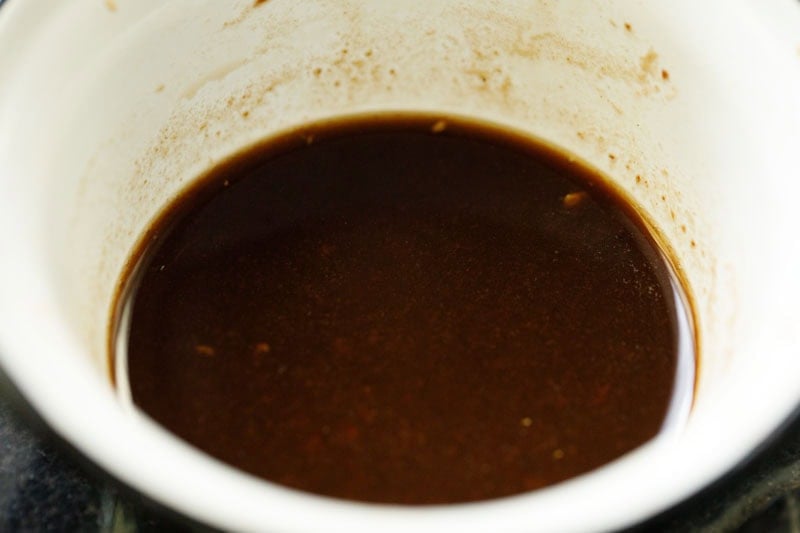

Prep Rice Noodles, Veggies & Garnishes
3. Cook 200 grams of flat rice noodles according to the package instructions until al dente.
Depending on the brand, you may need to boil them for a few minutes or soak them in hot water for 25 to 30 minutes until tender yet firm. Drain well to prevent sticking.
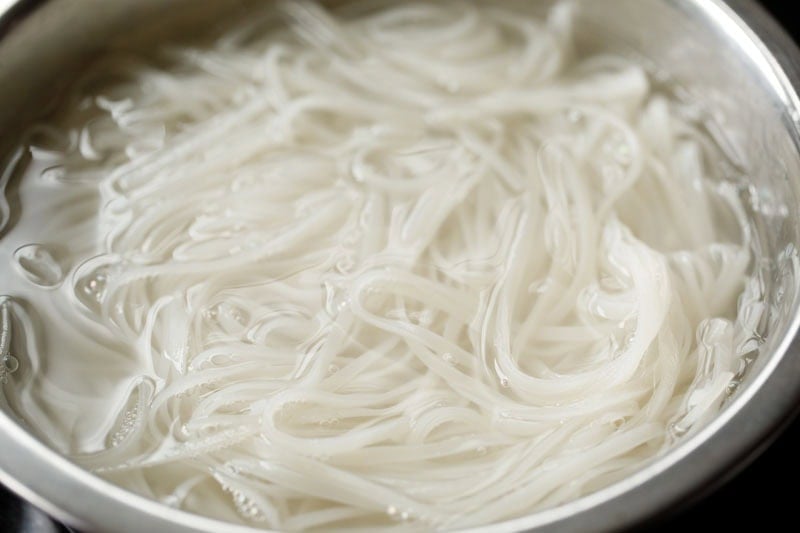

4. For this recipe, I used 4 cups of water to cook the noodles. Once cooked al dente, drain them using a strainer or colander and let them cool completely.
You can optionally rinse the cooked noodles again in water – this stops the cooking process and helps prevent clumping.
Rinse, chop, and prepare all the vegetables and mushrooms. Finely chop the garlic.
If using raw peanuts, toast or roast them in a skillet or oven until crunchy. Let them cool, then coarsely crush using a mortar and pestle or a food processor. Avoid grinding into a fine powder.
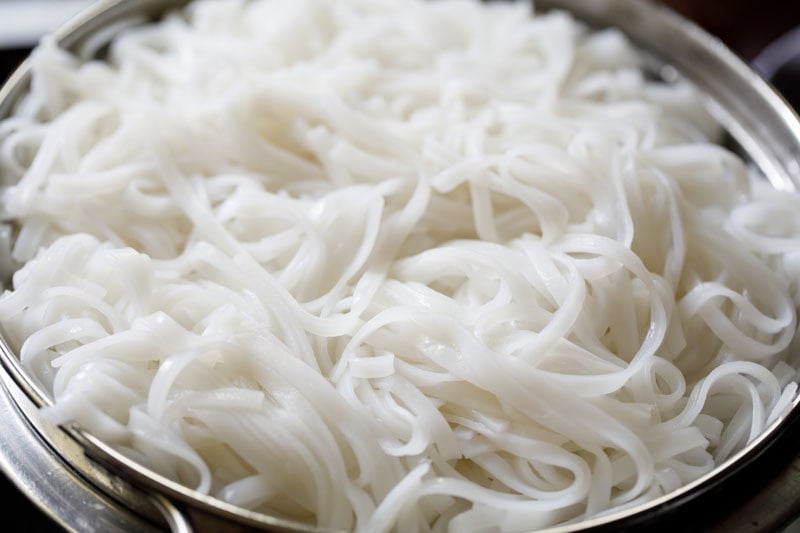

Sauté Aromatics, Mushrooms & Veggies
5. In a heavy wok or pan, heat 3 tablespoons oil on high heat. Add ½ cup sliced spring onion whites and 2 teaspoons finely chopped garlic.
Stir-fry for 1 minute until aromatic.
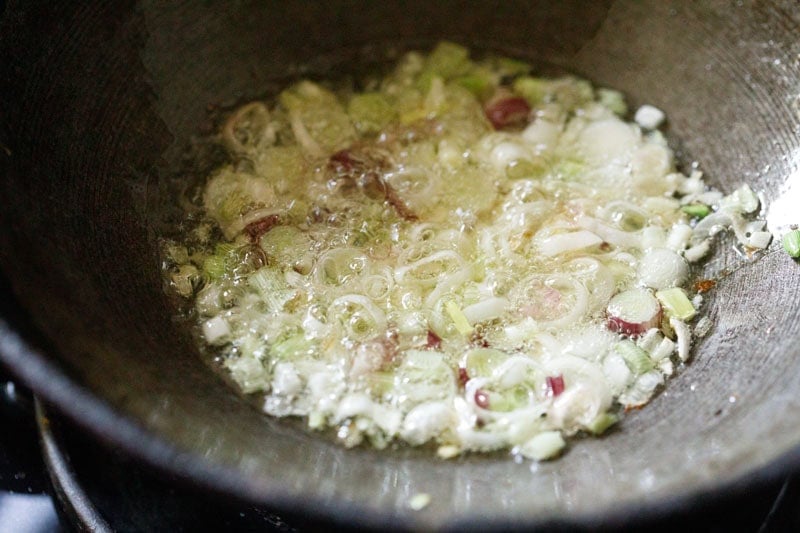

6. Add 3 cups sliced mushrooms, ⅓ cup finely chopped carrots and ½ cup sliced baby corn.
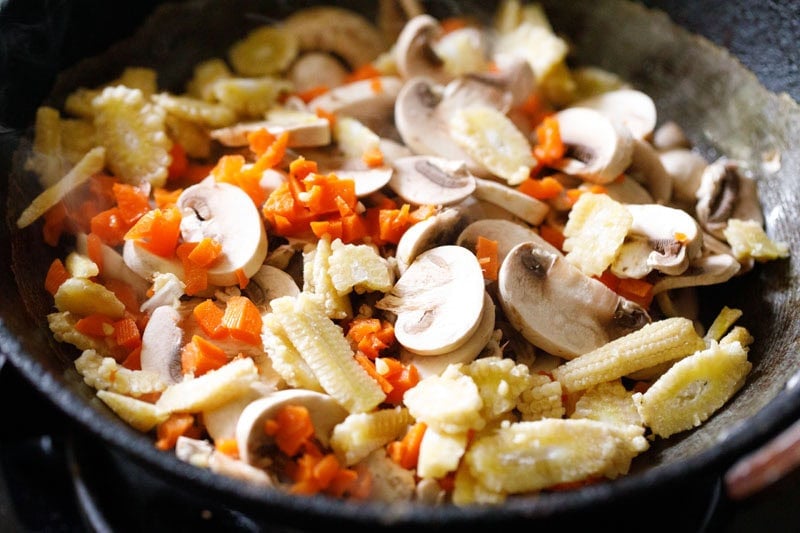

7. Stir-fry until the mushrooms release their moisture and the mixture becomes fairly dry.
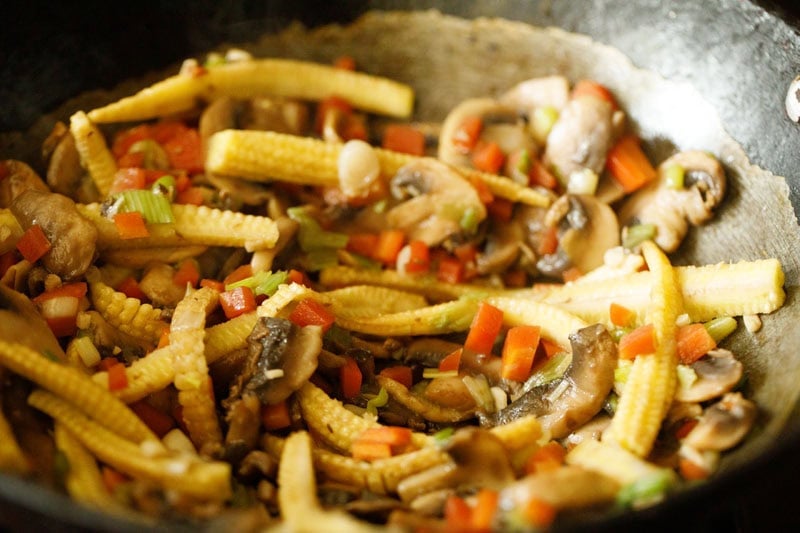

8. Next, add 1 cup sliced green bell pepper and stir-fry for 2 to 3 minutes on high heat.
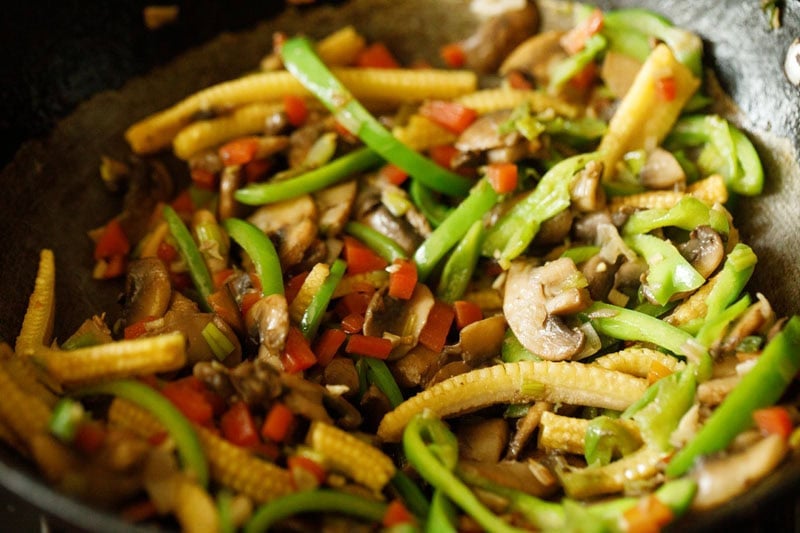

Make Sauce
9. Add 1 teaspoon red chili flakes and 1 teaspoon oyster mushroom powder (optional).
Pour in the prepared tamarind water, 2 tablespoons dark soy sauce, 1 tablespoon rice vinegar, ¼ cup palm sugar and salt to taste.
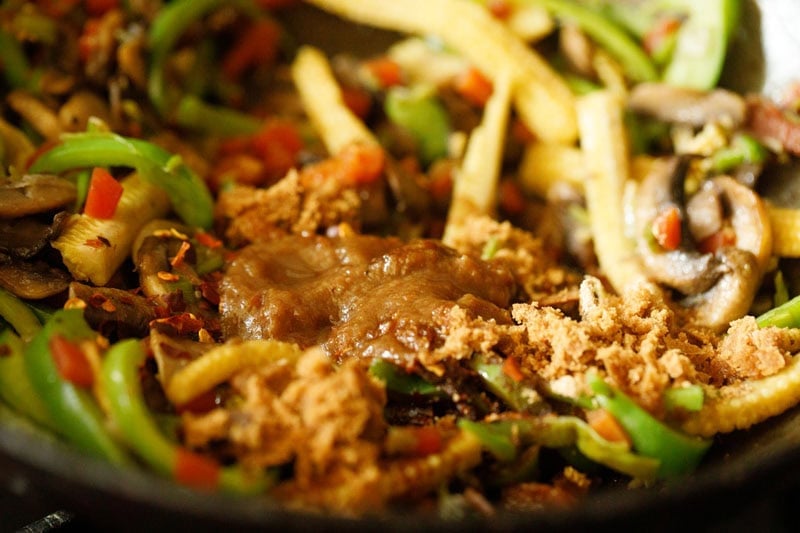

10. Mix everything well and simmer on medium heat for 4 to 5 minutes or until the sauce thickens slightly.
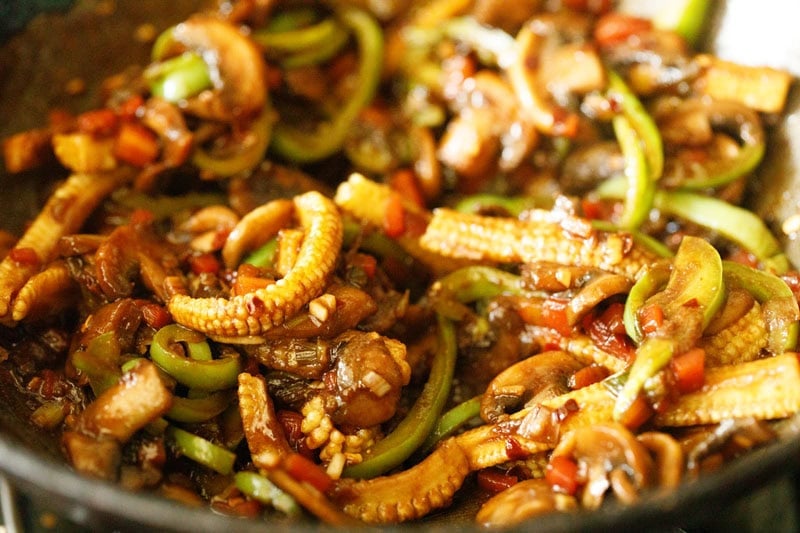

Make Pad Thai
11. Add the cooked and cooled rice noodles. Gently mix until the noodles are evenly coated with the sauce.
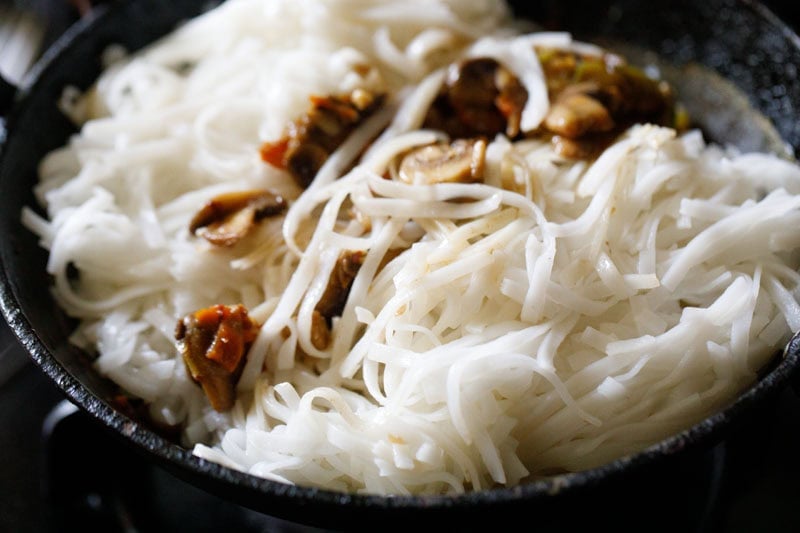

12. Taste and adjust the seasoning. You can add more soy sauce, tamarind or sugar as per your preference.
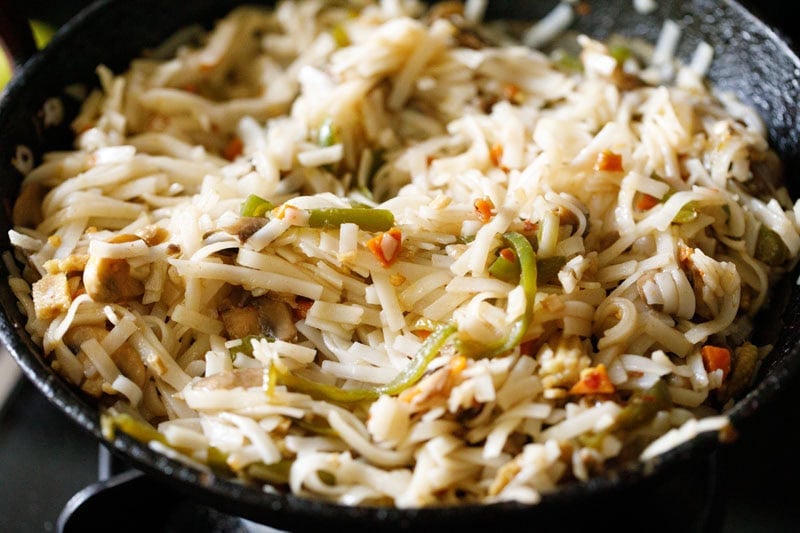

13. Serve portions of Pad Thai in plates or bowls. Garnish with ¼ to ⅓ cup chopped spring onion greens (divided), ½ cup coarsely crushed roasted peanuts (divided) and lime wedges.
To add a touch of freshness, you can optionally garnish with coriander leaves (cilantro).
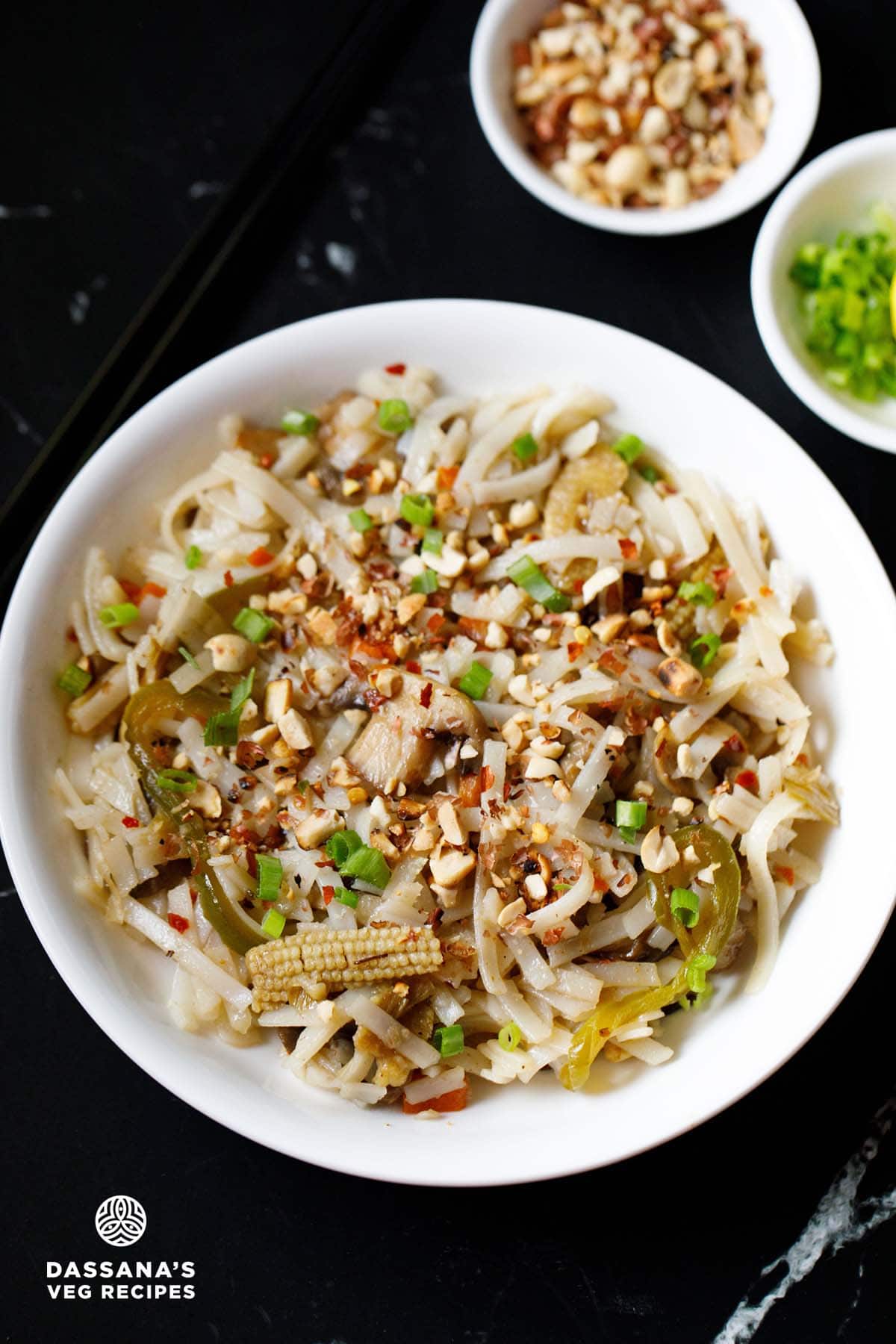

Serving & Storage Suggestions
Best enjoyed hot or warm. Serve as a main course for lunch or dinner, paired with a light soup or salad. Tom Kha Soup and Tom Yum Soup are some lovely pairings.
You can also serve it with crispy Vegetable Spring Rolls or refreshing Thai Green Papaya Salad to make it a complete Thai-style meal.
For dessert, consider something light and tropical like Thai Mango Pudding – a smooth, chilled dessert made with ripe mangoes and coconut milk.
Refrigeration isn’t ideal as it alters the taste and flavor. However, if you must store it, reheat by sprinkling a little water to prevent dryness, then gently sauté in a skillet or warm it up in a pan.
If refrigerating, store in an airtight container and consume within a day for best results.
Expert Tips
- Rice noodles: Avoid overcooking – they should be tender with a slight chewy (al dente).
- Cooling the noodles: Allow the noodles to cool completely before stir-frying to prevent them from becoming sticky or clumping together.
- Noodle alternatives: If flat rice noodles aren’t available, any similar flat noodle variety can be used as a substitute.
- Pickled radish: While traditional Pad Thai Recipe uses pickled daikon, this version skips it, relying on veggies and sauce for crunch and flavor. Feel free to include it if you have some.
- Must-have toppings: Don’t skip the crushed peanuts and a squeeze of lime juice – they really enhance the dish.
- Tofu & sprouts option: Add cubes of extra-firm tofu, pan-fried until golden, along with mung bean sprouts for extra texture and protein.
- Optional freshness: Garnish with chopped coriander (cilantro) for a burst of fresh, herbal flavor.
- Oil type: Use a neutral oil (like sunflower or avocado) for stir-frying to avoid overpowering the sauce flavor.
- Heat control: Use a heavy wok and stir-fry on medium-high to high heat for best texture and and quick caramelization. Regulate the heat as needed.
FAQs
Traditional Pad Thai uses thin flat rice noodles. Depending on the brand, you may need to either boil them briefly or soak them in warm water for about 30 minutes until they soften and become pliable enough for stir-frying.
To make it gluten-free, substitute the soy sauce with tamari or a gluten-free alternative. The rest of the ingredients are naturally gluten-free.
You can replace it with a combination of lime juice and a small amount of brown sugar, but keep in mind the flavor won’t be exactly the same.
Simply reduce the quantity of sugar or palm sugar in the sauce to suit your taste.
Absolutely! Add vegetables such as bell peppers, zucchini, carrots, snap peas, or even spinach. Just make sure they complement the sauce and don’t overpower the overall taste and flavor.
Make sure to cook the noodles to an al-dente texture. Additionally cool the noodles after cooking and toss them with a few drops of oil. Avoid overcooking, and stir-fry on medium-high to high heat quickly.
Pad Thai is best enjoyed fresh, but you can prep the sauce and chopped vegetables in advance to save time. Combine and stir-fry everything just before serving.
More Thai Recipes To Try!
Please be sure to rate the recipe in the recipe card or leave a comment below if you have made it. For more vegetarian inspirations, Sign Up for my emails or follow me on Instagram, Youtube, Facebook, Pinterest or Twitter.
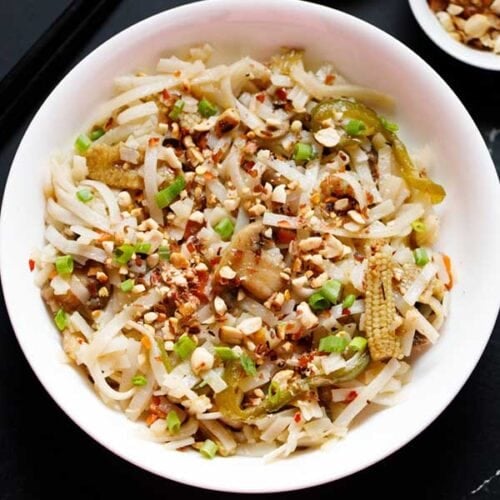

Pad Thai Recipe
Pad Thai is a classic Thai stir-fried noodle dish made with rice noodles, a sweet-tangy tamarind sauce, vegetables, tofu or meat, and garnished with peanuts, lime, and herbs. My homemade version is a Pad Thai-inspired vegetarian recipe made without fish sauce or eggs, using fresh tamarind water, mushrooms, seasonal vegetables, and roasted peanuts – deliciously balanced and perfect for weeknight meals.
Prep Time 15 minutes
Cook Time 25 minutes
Total Time 40 minutes
Prevent your screen from going dark while making the recipe
Prepare Tamarind Water
- Soak tamarind in ¼ cup hot water for 15 to 20 minutes. Mash and strain to extract the pulp. Alternatively, use 1 to 2 tablespoons tamarind paste directly when making the sauce.
Stir-Fry the Vegetables & Mushrooms
Heat oil in a heavy wok on high flame.
Add sliced scallion whites and chopped garlic. Stir-fry for about 1 minute.
Add mushrooms, carrots, and baby corn. Stir-fry on high heat until all the moisture evaporates.
Add green bell pepper and stir-fry for 2 to 3 minutes.
Add Sauces & Spices
Add red chilli flakes and oyster mushroom powder (optional).
Pour in the tamarind water (or paste), soy sauce, rice vinegar (or lime juice), palm sugar, and salt to taste.
Mix thoroughly and simmer on medium heat for 4 to 5 minutes or until the sauce thickens slightly.
Combine with Noodles & Make Pad Thai
Garnish and Serve:
Garnish with chopped scallion greens, crushed roasted peanuts, and lime wedges.
Serve hot, optionally topped with fresh coriander leaves or Thai basil.
- Always use a heavy wok and stir-fry on medium-high to high heat for the best texture and flavor. Remember to regulate the heat as needed while stir-frying.
- Palm sugar can be adjusted to your preferred level of sweetness.
- Instead of palm sugar you can add brown sugar, raw sugar or regular granulated white sugar. Add according to taste.
- Feel free to include tofu, sprouts and other veggies like zucchini or snow peas for variation.
- After soaking or cooking, rinse the rice noodles in cold water and drain well to stop the cooking process and prevent clumping.
- Make sure the stir-fried vegetables have a slight crunch to balance the soft noodles.
- If the sauce thickens too much while cooking, sprinkle in a tablespoon or two of warm water to loosen it.
- Prep all ingredients before you begin stir-frying, as the cooking process moves quickly.
- Adjust chili flakes to your spice preference – start with less and add more later if needed.
- Use roasted unsalted peanuts for garnish, and crush them coarsely for the best texture.
- Fresh lime juice adds brightness and a nice tangy flavor. So try not to skip it.
Nutrition Facts
Pad Thai Recipe
Amount Per Serving
Calories 673 Calories from Fat 252
% Daily Value*
Fat 28g43%
Saturated Fat 4g25%
Polyunsaturated Fat 4g
Monounsaturated Fat 18g
Sodium 1257mg55%
Potassium 906mg26%
Carbohydrates 98g33%
Fiber 9g38%
Sugar 19g21%
Protein 16g32%
Vitamin A 3127IU63%
Vitamin B1 (Thiamine) 0.3mg20%
Vitamin B2 (Riboflavin) 1mg59%
Vitamin B3 (Niacin) 9mg45%
Vitamin B6 1mg50%
Vitamin B12 0.04µg1%
Vitamin C 70mg85%
Vitamin D 0.2µg1%
Vitamin E 8mg53%
Vitamin K 59µg56%
Calcium 89mg9%
Vitamin B9 (Folate) 83µg21%
Iron 3mg17%
Magnesium 100mg25%
Phosphorus 363mg36%
Zinc 2mg13%
* Percent Daily Values are based on a 2000 calorie diet.

Source link